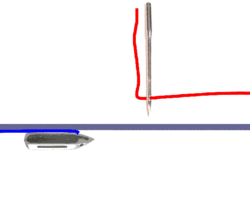History of the Sewing Machine: Study
Hand sewing is an art form that is over 20,000 years old. The first sewing needles were made of bones or animal horns and the first thread was made of animal sinew. Iron needles were invented in the 14th century. The first eyed needles appeared in the 15th century.
Birth of Mechanical Sewing
The first possible patent connected to mechanical sewing was a 1755 British patent issued to German, Charles Weisenthal. Weisenthal was issued a patent for a needle that was designed for a machine, however, the patent did not describe the rest of the machine if one existed.
Several Inventors Attempt to Improve Sewing
The English inventor and cabinet maker, Thomas Saint was issued the first patent for a complete machine for sewing in 1790. It is not known if Saint actually built a working prototype of his invention. The patent describes an awl that punched a hole in leather and passed a needle through the hole. A later reproduction of Saint's invention based on his patent drawings did not work.
In 1810, German, Balthasar Krems invented an automatic machine for sewing caps. Krems did not patent his invention and it never functioned well.
Austrian tailor, Josef Madersperger made several attempts at inventing a machine for sewing and was issued a patent in 1814. All of his attempts were considered unsuccessful.
In 1804, a French patent was granted to Thomas Stone and James Henderson for "a machine that emulated hand sewing." That same year a patent was granted to Scott John Duncan for an "embroidery machine with multiple needles." Both inventions failed and were soon forgotten by the public.
In 1818, the first American sewing machine was invented by John Adams Doge and John Knowles. Their machine failed to sew any useful amount of fabric before malfunctioning.
Barthelemy Thimonnier - First Functional Machine & a Riot
The first functional sewing machine was invented by the French tailor, Barthelemy Thimonnier, in 1830. Thimonnier's machine used only one thread and a hooked needle that made the same chain stitch used with embroidery. The inventor was almost killed by an enraged group of French tailors who burnt down his garment factory because they feared unemployment as a result of his new invention.
would
A sewing machine is a textile machine used to stitch fabric, cards and other material together with thread. Sewing machines were invented during the first Industrial Revolution to decrease the amount of manual sewing work performed in clothing companies. Since the invention of the first working sewing machine, generally considered to have been the work of Englishman Thomas Saint in 1790,[1] the sewing machine has vastly improved the efficiency and productivity of fabric, clothing and needle industries.
Industrial sewing machines, by contrast, are larger, faster, more complex, and more varied in their size, cost, appearance, and task
The bobbin driver of a Husqvarna 3600 sewing machine
Sewing machines can make a great variety of plain or patterned stitches. Ignoring strictly decorative aspects, over three dozen distinct stitch formations are formally recognized by the ISO 4915:1991 standard. For a summary see involving one to seven separate threads to form the stitch. Plain stitches fall into four general categories: lockstitch, chainstitch, overlock, and coverstitch.
Main article: Lockstitch





